Advanced Calculus of Several Variables (1973)
Part IV. Multiple Integrals
Chapter 6. IMPROPER INTEGRALS AND ABSOLUTELY INTEGRABLE FUNCTIONS
Thus far in this chapter on integration, we have confined our attention to bounded functions that have bounded support. This was required by our definition of the integral of a nonnegative function as the volume of its ordinate set (if contented)—if f: ![]() n →
n → ![]() is to be integrable, then its ordinate set must be contented. But every contented set is a priori bounded, so f must be bounded and have bounded support.
is to be integrable, then its ordinate set must be contented. But every contented set is a priori bounded, so f must be bounded and have bounded support.
However there are certain types of unbounded subsets of ![]() n with which it is natural and useful to associate a notion of volume, and analogously functions which are either unbounded or have unbounded support, but for which it is nevertheless natural and useful to define an integral. The following two examples illustrate this.
n with which it is natural and useful to associate a notion of volume, and analogously functions which are either unbounded or have unbounded support, but for which it is nevertheless natural and useful to define an integral. The following two examples illustrate this.
Example 1Let f: [1, ∞) → ![]() be defined by f(x) = 1/x2. Let A denote the ordinate set of f, and An the part of A lying above the closed interval [1, n] (Fig. 4.39). Then
be defined by f(x) = 1/x2. Let A denote the ordinate set of f, and An the part of A lying above the closed interval [1, n] (Fig. 4.39). Then
![]()
Since ![]() and limn→∞ v(An) = 1, it would seem natural to say that
and limn→∞ v(An) = 1, it would seem natural to say that
![]()
despite the fact that f does not have bounded support. (Of course what we really mean is that our definitions of volume and/or the integral ought to be extended so as to make this true.)
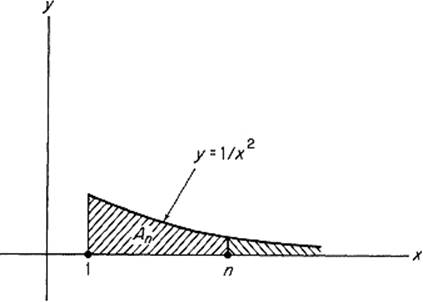
Figure 4.39
Example 2Let f be the unbounded function defined on (0, 1 ] by ![]() . Let A denote the ordinate set of f, and An the part of A lying above the closed interval [1/n, 1] (Fig. 4.40). Then
. Let A denote the ordinate set of f, and An the part of A lying above the closed interval [1/n, 1] (Fig. 4.40). Then
![]()
Since ![]() and limn→∞ v(An) = 2, it would seem natural to say that
and limn→∞ v(An) = 2, it would seem natural to say that
![]()
These two examples indicate both the need for some extension (to unbounded situations) of our previous definitions, and a possible method of making this extension. Given a function f : U → ![]() , with either f or U (or both) unbounded,
, with either f or U (or both) unbounded,
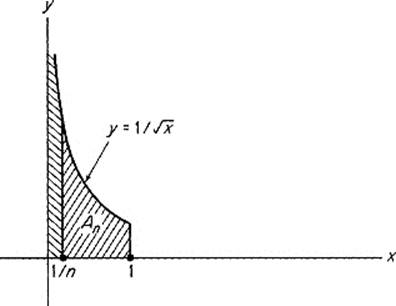
Figure 4.40
we might choose a sequence ![]() of subsets of U which “fill up” U in some appropriate sense, on each of which f is integrable, and then define
of subsets of U which “fill up” U in some appropriate sense, on each of which f is integrable, and then define
![]()
provided that this limit exists. Of course we would have to verify that ∫U f is thereby well-defined, that is, that its value is independent of the particular chosen sequence ![]() . Partly because of this problem of well-definition, we shall formulate our initial definition of ∫U f in a slightly different manner, and then return later to the interpretation of ∫Uf as a sequential limit (as above).
. Partly because of this problem of well-definition, we shall formulate our initial definition of ∫U f in a slightly different manner, and then return later to the interpretation of ∫Uf as a sequential limit (as above).
We deal first with the necessity for f : U → ![]() to be integrable on enough subsets of U to “fill up” U. We say that f is locally integrable on U if and only if f is integrable on every compact (closed and bounded) contented subset of U. For instance the function f(x) = 1/x2 of Example 1 is not integrable on (1, ∞), but is locally integrable there. Similarly the function f(x) = 1/x½ of Example 2 is not integrable on (0, 1), but is locally integrable there.
to be integrable on enough subsets of U to “fill up” U. We say that f is locally integrable on U if and only if f is integrable on every compact (closed and bounded) contented subset of U. For instance the function f(x) = 1/x2 of Example 1 is not integrable on (1, ∞), but is locally integrable there. Similarly the function f(x) = 1/x½ of Example 2 is not integrable on (0, 1), but is locally integrable there.
It will be convenient to confine our attention to open domains of definition. So let f : U → ![]() be a locally integrable function on the open set
be a locally integrable function on the open set ![]() . We then say that f is absolutely integrable on U if and only if, given ε > 0, there exists a compact contented subset Bε of U such that
. We then say that f is absolutely integrable on U if and only if, given ε > 0, there exists a compact contented subset Bε of U such that
![]()
for every compact contented set ![]() which contains Bε.
which contains Bε.
The student should verify that the sum of two absolutely integrable functions on U is absolutely integrable, as is a constant multiple of one, so the set of all absolutely integrable functions on U is a vector space. This elementary fact will be used in the proof of the following proposition, which provides the reason for our terminology.
Proposition 6.1If the function f : U → ![]() is absolutely integrable, then so is its absolute value
is absolutely integrable, then so is its absolute value ![]() f
f![]() .
.
We will later prove the converse, so f is absolutely integrable if and only if ![]() f
f![]() is.
is.
PROOFWriting f = f+ − f−, it suffices by the above remark to show that f+ and f− are both absolutely integrable, since ![]() f
f![]() = f+ + f−. We consider f+. Given ε > 0, choose Bε as in the definition, such that
= f+ + f−. We consider f+. Given ε > 0, choose Bε as in the definition, such that ![]() implies
implies
![]()
if A is a compact contented subset of U. It will suffice to show that ![]() also implies that
also implies that
![]()
Given a compact contented set A with ![]() , define
, define
![]()
so that f(x) = f+(x) for ![]() , and
, and
![]()
because f+(x) = 0 if ![]() . Then
. Then

as desired, because A+ is a compact contented set such that ![]() .
.
![]()
The number I, which the following theorem associates with the absolutely integrable function f on the open set ![]() , will be called the improper (Riemann) integral of f on U. It will be temporarily denoted by IUf (until we have verified that IUf = ∫Uf in case f is integrable on U).
, will be called the improper (Riemann) integral of f on U. It will be temporarily denoted by IUf (until we have verified that IUf = ∫Uf in case f is integrable on U).
The following definition will simplify the interpretation of IUf as a sequential limit of integrals of f on compact contented subsets of U. The sequence ![]() of compact contented subsets of U is called an approximating sequencefor U if (a)
of compact contented subsets of U is called an approximating sequencefor U if (a) ![]() for each
for each ![]() , and (b)
, and (b) ![]() .
.
Theorem 6.2 Suppose f is absolutely integrable on the open set ![]() . Then there exists a number I = IUf with the property that, given ε > 0, there exists a compact contented set Cε such that
. Then there exists a number I = IUf with the property that, given ε > 0, there exists a compact contented set Cε such that
![]()
for every compact contented subset A of U containing Cε. Furthermore
![]()
for every approximating sequence ![]() for U.
for U.
PROOFTo start with, we choose a (fixed) approximating sequence ![]() for U (whose existence is provided by Exercise 6.16). Given η > 0, the Heine-Borel theorem (see the Appendix) implies that
for U (whose existence is provided by Exercise 6.16). Given η > 0, the Heine-Borel theorem (see the Appendix) implies that ![]() if k is sufficiently large. Here Bη/2 is the compact contented subset of U (provided by the definition) such that
if k is sufficiently large. Here Bη/2 is the compact contented subset of U (provided by the definition) such that ![]() implies that
implies that
![]()
Consequently, if k and l are sufficiently large, it follows that
![]()
Thus ![]() is a Cauchy sequence of numbers, and therefore has a limit I (see the Appendix).
is a Cauchy sequence of numbers, and therefore has a limit I (see the Appendix).
Now let Cε = Bε/3. Given a compact contented subset A of U which contains Cε, choose a fixed k sufficiently large that ![]() and
and ![]() . Then
. Then

as desired. This completes the proof of the first assertion.
Now let ![]() be an arbitrary approximating sequence for U. Given δ > 0, choose K sufficiently large that
be an arbitrary approximating sequence for U. Given δ > 0, choose K sufficiently large that ![]() , for all
, for all ![]() . Then what we have just proved gives
. Then what we have just proved gives ![]() for all
for all ![]() , so it follows that
, so it follows that
![]()
We can now show that IUf and ∫Uf are equal when both are defined. Note that, if f is integrable on the open set ![]() , then it follows from Exercise 3.1 that f is locally integrable on U (why?).
, then it follows from Exercise 3.1 that f is locally integrable on U (why?).
Theorem 6.3If ![]() is open and f : U →
is open and f : U → ![]() is integrable, then f is absolutely integrable, and
is integrable, then f is absolutely integrable, and
![]()
PROOFLet M be an upper bound for the values of ![]() f(x)
f(x)![]() on U. Given ε > 0, let Bε be a compact contented subset of U such that v(U − Bε) < ε/M. If A is a compact contented subset of U which contains Bε, then
on U. Given ε > 0, let Bε be a compact contented subset of U such that v(U − Bε) < ε/M. If A is a compact contented subset of U which contains Bε, then

so it follows that f is absolutely integrable on U.
If in addition A contains the set Cε of Theorem 6.2, then
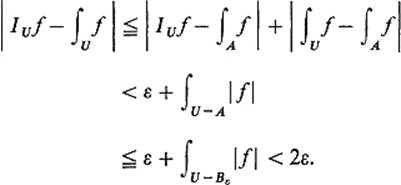
This being true for all ε > 0, it follows that IUf = ∫Uf.
![]()
In order to proceed to compute improper integrals by taking limits over approximating sequences as in Theorem 6.2, we need an effective test for absolute integrability. For nonnegative functions, this is easy to provide. We say that the improper integral ∫Uf is bounded (whether or not it exists, that is, whether or not f is absolutely integrable on U) if and only if there exists M > 0 such that
![]()
for every compact contented subset A of U.
Theorem 6.4Suppose that the nonnegative function f is locally integrable on the open set U. Then f is absolutely integrable on U if and only if ∫Uf is bounded, in which case ∫Uf is the least upper bound of the values ∫Af, for all compact contented sets ![]() .
.
PROOFSuppose first that (1) holds, and denote by I the least upper bound of {∫Af} for all compact contented ![]() . Given ε > 0, I − ε is not an upper bound for the numbers {∫Af}, so there exists a compact contented set
. Given ε > 0, I − ε is not an upper bound for the numbers {∫Af}, so there exists a compact contented set ![]() such that
such that
![]()
If A is any compact contented set such that ![]() then, since
then, since ![]() , we have
, we have
![]()
so it follows that both
![]()
The first inequality implies that f is absolutely integrable, and then the second implies that ∫Uf = I as desired (using Theorem 6.2).
Conversely, if f is absolutely integrable on U, then it is easily seen that ![]() for every compact contented subset U of A, so we can take M = ∫Uf in (1).
for every compact contented subset U of A, so we can take M = ∫Uf in (1).
![]()
Corollary 6.5Suppose the nonnegative function f is locally integrable on the open set U, and let ![]() be an approximating sequence for U. Then f is absolutely integrable with
be an approximating sequence for U. Then f is absolutely integrable with
![]()
provided that this limit exists (and is finite).
PROOFThe fact that the monotone increasing sequence of numbers ![]() is bounded (because it has a finite limit) implies easily that ∫Uf is bounded, so f is absolutely integrable by Theorem 6.4. Hence (2) follows from Theorem 6.2.
is bounded (because it has a finite limit) implies easily that ∫Uf is bounded, so f is absolutely integrable by Theorem 6.4. Hence (2) follows from Theorem 6.2.
![]()
As an application, we will now generalize see Examples 1 and 2 to ![]() n. Let A denote the solid annular region
n. Let A denote the solid annular region ![]() (Fig. 4.41), and let f be a spherically symmetric continuous function on A. That is,
(Fig. 4.41), and let f be a spherically symmetric continuous function on A. That is,
![]()
for some function g, where T : ![]() n →
n → ![]() n is the n-dimensional spherical coordinates mapping of Exercise 5.19. By part (a) of that exercise, and the change of variables theorem, we have
n is the n-dimensional spherical coordinates mapping of Exercise 5.19. By part (a) of that exercise, and the change of variables theorem, we have

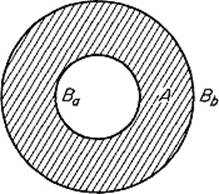
Figure 4.41
where
![]()
Example 3Let U = ![]() n − B1n and f(x) = 1/
n − B1n and f(x) = 1/![]() x
x![]() p where p > n. Writing Ak = Bkn − B1n, Corollary 6.5 and (3) above give
p where p > n. Writing Ak = Bkn − B1n, Corollary 6.5 and (3) above give

because kn−p → 0 since n − p < 0.
Example 4Let U denote the interior of the unit ball with the origin deleted, and f(x) = 1/![]() x
x![]() p with p < n. So now the problem is that f, rather than U, is unbounded. Writing
p with p < n. So now the problem is that f, rather than U, is unbounded. Writing ![]() , Corollary 6.5 and (3) give
, Corollary 6.5 and (3) give
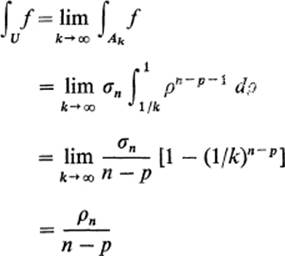
because p < n.
For nonnegative locally integrable functions, Corollary 6.5 plays in practice the role of a “working definition.” One need not worry in advance about whether the improper integral ∫Uf actually exists (that is, whether f is absolutely integrable on U). Simply choose a convenient approximating sequence ![]() for U, and compute
for U, and compute ![]() . If this limit is finite, then ∫Uf does exist, and its value is the obtained limit.
. If this limit is finite, then ∫Uf does exist, and its value is the obtained limit.
In the case of an arbitrary (not necessarily nonnegative) function, one must know in advance that f is absolutely integrable on U. Once this has been established, Theorem 6.2. enables us to proceed as above—choose an approximating sequence ![]() for U, and then compute
for U, and then compute ![]() .
.
The simplest way to show that a given locally integrable function f : U → ![]() is absolutely integrable is to compare it with a function g : U →
is absolutely integrable is to compare it with a function g : U → ![]() which is already known to be absolutely integrable, using the comparison test stated below. First we need the converse of Proposition 6.1.
which is already known to be absolutely integrable, using the comparison test stated below. First we need the converse of Proposition 6.1.
Corollary 6.6Let f : U → ![]() be locally integrable. If
be locally integrable. If ![]() f
f![]() is absolutely integrable on U, then so is f.
is absolutely integrable on U, then so is f.
PROOFWrite f = f+ − f−, so ![]() f
f![]() = f+ + f−. Since
= f+ + f−. Since ![]() f
f![]() is absolutely integrable, ∫U
is absolutely integrable, ∫U![]() f
f![]() is bounded (by Theorem 6.4). It follows immediately that ∫Uf+ and ∫Uf− are bounded. Hence Theorem 6.4 implies that f+ and f− are both absolutely integrable on U, so f = f+ − f− is also.
is bounded (by Theorem 6.4). It follows immediately that ∫Uf+ and ∫Uf− are bounded. Hence Theorem 6.4 implies that f+ and f− are both absolutely integrable on U, so f = f+ − f− is also.
![]()
The import of Corollary 6.6 is that, in practice, we need only to test nonnegative functions for absolute integrability.
Corollary 6.7(Comparison Test) Suppose that f and g are locally integrable on U with ![]() . If g is absolutely integrable on U, then so is f.
. If g is absolutely integrable on U, then so is f.
PROOFSince g is absolutely integrable, ∫Ug is bounded (by Theorem 6.4). But then the fact that ![]() implies immediately that ∫Uf is also bounded, so f is also absolutely integrable.
implies immediately that ∫Uf is also bounded, so f is also absolutely integrable.
![]()
Example 5 The functions
![]()
are all absolutely integrable on U = (1, ∞), by comparison with the absolutely integrable function g(x) = 1/x2 of Examples 1 and 3. For the latter, we note that
![]()
so ![]() sin x/x2
sin x/x2![]() is absolutely integrable by Corollary 6.7. But then it follows from Corollary 6.6 that (sin x)/x2 itself is absolutely integrable on (1, ∞).
is absolutely integrable by Corollary 6.7. But then it follows from Corollary 6.6 that (sin x)/x2 itself is absolutely integrable on (1, ∞).
Similarly the functions
![]()
are absolutely integrable on U = (0, 1), by comparison with the function g(x) = 1/x1/2 of Examples 2 and 4.
Next we want to define a different type of improper integral for the case of functions of a single variable. Suppose that f is locally integrable on the open interval (a, b), where possibly a = − ∞ or b = + ∞ or both. We want to define the improper integral denoted by
![]()
to be contrasted with the improper integral ∫(a, b)f(x) dx which is defined if f is absolutely integrable on (a, b). It will turn out that ![]() exists in some cases where f is not absolutely integrable on (a, b), but that
exists in some cases where f is not absolutely integrable on (a, b), but that ![]() if both exist.
if both exist.
The new improper integral ![]() is obtained by restricting our attention to a single special approximating sequence for (a, b), instead of requiring that the same limit be obtained for all possible choices of the approximating sequence (as, by Theorem 6.2., is the case if f is absolutely integrable). Separating the four possible cases, we define
is obtained by restricting our attention to a single special approximating sequence for (a, b), instead of requiring that the same limit be obtained for all possible choices of the approximating sequence (as, by Theorem 6.2., is the case if f is absolutely integrable). Separating the four possible cases, we define

(where a and b are finite), provided that the appropriate limit exists (and is finite) and say that the integral converges; otherwise it diverges.
Example 6The integral ![]() converges, because
converges, because
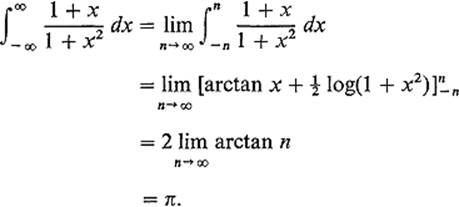
However f(x) = (1 + x)/(1 + x2) is not absolutely integrable on (− ∞, ∞) = ![]() . If it were, we would have to obtain the same limit π for any approximating sequence
. If it were, we would have to obtain the same limit π for any approximating sequence ![]() for
for ![]() . But, taking An = [−n, 2n], we obtain
. But, taking An = [−n, 2n], we obtain
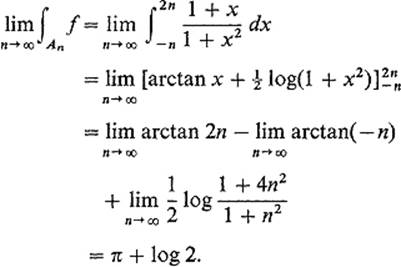
Example 7Consider ![]() . Since limx→0[(sin x)/x] = 1, sin x/x is continuous on [0, 1]. So we need only consider the convergence of
. Since limx→0[(sin x)/x] = 1, sin x/x is continuous on [0, 1]. So we need only consider the convergence of

But (cos x)/x2 is absolutely convergent on (1, ∞), by comparison with 1/x2.
Therefore ![]() converges; its actual value is π/2 (see Exercise 6.14). However the function f(x) = (sin x)/x is not absolutely integrable on (0, ∞) (see Exercise 6.15).
converges; its actual value is π/2 (see Exercise 6.14). However the function f(x) = (sin x)/x is not absolutely integrable on (0, ∞) (see Exercise 6.15).
The phenomenon illustrated by Examples 6 and 7, of ![]() converging despite the fact that f is not absolutely convergent on (a, b), does not occur when f is nonnegative.
converging despite the fact that f is not absolutely convergent on (a, b), does not occur when f is nonnegative.
Theorem 6.8Suppose f : (a, b) → ![]() is locally integrable with
is locally integrable with ![]() . Then f is absolutely integrable if and only if
. Then f is absolutely integrable if and only if ![]() converges, in which case
converges, in which case
![]()
PROOFThis follows immediately from Theorem 6.2. and Corollary 6.5.
![]()
Example 8We want to compute ![]() , which converges because
, which converges because ![]() , while
, while
![]()
To obtain the value, we must resort to a standard subterfuge.
Consider f : ![]() 2 →
2 → ![]() defined by
defined by ![]() . Since
. Since
![]()
when x2 + y2 is sufficiently large, it follows from Example 3 and the comparison test that ![]() is absolutely integrable on
is absolutely integrable on ![]() 2. If Dn denotes the disk of radius n in
2. If Dn denotes the disk of radius n in ![]() 2, then
2, then

On the other hand, if Sn denotes the square with edgelength 2n centered at the origin, then
![]()
Comparing the two results, we see that
![]()
Since ![]() is an even function, it follows that
is an even function, it follows that
![]()
Example 9The important gamma function Γ : (0, ∞) → ![]() is defined by
is defined by
![]()
We must show that this improper integral converges for all x > 0. Now
![]()
If ![]() , then f(t) = tx−1 e−t is continuous on [0, 1]. If
, then f(t) = tx−1 e−t is continuous on [0, 1]. If ![]() , then
, then ![]() , so the first integral on the right converges, because g(t) = tx−1 is absolutely convergent on (0, 1) by Example 4, since 1 − x < 1.
, so the first integral on the right converges, because g(t) = tx−1 is absolutely convergent on (0, 1) by Example 4, since 1 − x < 1.
To consider the second integral, note first that
![]()
so
![]()
for t sufficiently large. Since 1/t2 is absolutely convergent on (1, ∞), it follows that ![]() converges.
converges.
The fundamental property of the gamma function is that Γ(x + 1) = xΓ(x) if x > 0:
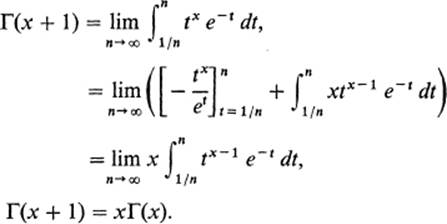
Since Γ(1) = 1, it follows easily that
![]()
if n is a positive integer (Exercise 6.1).
Example 10The beta function is a function of two variables, defined on the open first quadrant Q of the xy-plane by
![]()
If either x < 1 or y < 1 or both, this integral is improper, but can be shown to converge by methods similar to those used with the gamma function (Exercise 6.9).
Substituting t = sin2 θ in (6) (before taking the limit in the improper cases), we obtain the alternative form
![]()
The beta function has an interesting relation with the gamma function. To see this, we first express the gamma function in the form
![]()
by substituting t = u2 in (5). From this it follows that

This last equality is easily verified by use of the approximating sequence ![]() for Q, where An = [1/n, n] × [1/n, n].
for Q, where An = [1/n, n] × [1/n, n].
It follows from Corollary 6.5 that the integrand function in (9) is absolutely convergent, so we may use any other approximating sequence we like. Let us try ![]() , where Bn is the set of all those points with polar coordinates (r, θ) such that
, where Bn is the set of all those points with polar coordinates (r, θ) such that ![]() and
and ![]() (Fig. 4.42). Then
(Fig. 4.42). Then

using (7) and (8) and the obvious symmetry of the beta function. Hence
![]()

Figure 4.42
As a typical application of (7) and (10), we obtain

Another typical example of the use of gamma functions to evaluate integrals is
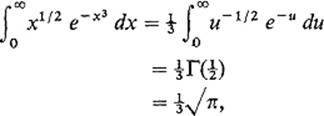
making the substitution u = x3 and using the fact that ![]() (Exercise 6.2).
(Exercise 6.2).
Exercises
6.1Show that Γ(1) = 1, and then deduce from Γ(x + 1) = xΓ(x) that Γ(n + 1) = n!.
6.2Show that ![]() . Hint: Substitute t = u2 in the integral defining
. Hint: Substitute t = u2 in the integral defining ![]() , and refer to Example 8. Then prove by induction on the positive integer n that
, and refer to Example 8. Then prove by induction on the positive integer n that
![]()
6.3Recalling from the previous exercise section the formulas for the volume αn of the unit n-dimensional ball ![]() , deduce from the previous two exercises that
, deduce from the previous two exercises that
![]()
for all ![]() .
.
6.4Apply Exercises 6.1 and 6.2, and formulas (7) and (10), to obtain a new derivation of

6.5Show that ![]() by subtituting x = t1/2.
by subtituting x = t1/2.
6.6Use the substitution t = xn to show that
![]()
6.7 Use the substitution x = e−u to show that
![]()
6.8Show that
![]()
6.9Prove that the integral defining the beta function converges.
6.10Show that the mass of a spherical ball of radius a, with density function d(x, y, z) = x2y2z2, is M = 4πa9/945. Hint: Calculate the mass of the first octant. Introduce spherical coordinates, and use formulas (7) and (10).
6.11Use ellipsoidal coordinates to show that the mass of the ellipsoidal ball ![]() , with density function d(x, y, z) = x2 + y2 + z2, is
, with density function d(x, y, z) = x2 + y2 + z2, is
![]()
6.12By integration by parts show that
![]()
Deduce from this recursion formula that
![]()
and
![]()
Apply Exercises 6.1 and 6.2 to conclude that
![]()
for all integers ![]() .
.
6.13The purpose of this exercise is to give a final computation of the volume αn of the unit ball ![]() .
.
(a)Let T : ![]() n →
n → ![]() n be the n-dimensional spherical coordinates mapping of Exercise 5.19. Note by inspection of the definition of T, without computing it explicitly, that the Jacobian of T is of the form
n be the n-dimensional spherical coordinates mapping of Exercise 5.19. Note by inspection of the definition of T, without computing it explicitly, that the Jacobian of T is of the form
![]()
for some function γ.
(b)Let f: ![]() n →
n → ![]() be an absolutely integrable function such that g = f
be an absolutely integrable function such that g = f ![]() T is a function of ρ alone. Then show that
T is a function of ρ alone. Then show that
![]()
for some constant Cn (independent of f). Setting f = g = 1 on Bn, a = 1, we see that αn = Cn/n, so it suffices to compute Cn.
(c)Taking limits in (*) as a → ∞, we obtain
![]()
so it suffices to find an absolutely integrable function f for which we can evaluate both of these improper integrals. For this purpose take
![]()
so ![]() . Conclude from Example 8 that
. Conclude from Example 8 that ![]() , and then apply the previous exercise to compute Cn, and thereby αn.
, and then apply the previous exercise to compute Cn, and thereby αn.
6.14The purpose of the problem is to evaluate
![]()
(a)First show that ![]() if x > 0.
if x > 0.
(b)Then use integration by parts to show that
![]()
(c)Hence
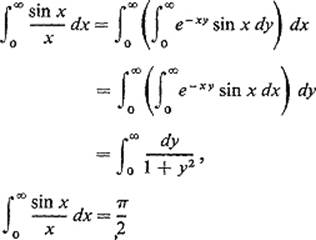
provided that the interchange of limit operations can be justified.
6.15The object of this problem is to show that f(x) = (sin x)/x is not absolutely integrable on (0, ∞). Show first that
![]()
Given any compact contented set ![]() , pick m such that
, pick m such that ![]() , and then define
, and then define
![]()
for all n > m. Now conclude, from the fact that ![]() diverges, that
diverges, that
![]()
Why does this imply that ∫(0, ∞) [(sin x)/x] dx does not exist?
6.16If U is an open subset of ![]() n, show that there exists an increasing sequence
n, show that there exists an increasing sequence ![]() of compact contented sets such that
of compact contented sets such that ![]() . Hint: Each point of U is contained in some closed ball which lies in U. Pick the sequence in such a way that Ak is the union of k closed balls.
. Hint: Each point of U is contained in some closed ball which lies in U. Pick the sequence in such a way that Ak is the union of k closed balls.
6.17Let q(x) = xtAx be a positive definite quadratic form on ![]() n. Then show that
n. Then show that
![]()
Outline:Let P be the orthogonal matrix provided by Exercise II.8.7, such that PtAP = P−1AP is the diagonal matrix whose diagonal elements are the (positive) eigenvalues λ1, . . . , λn of the symmetric matrix A. Use the linear mapping L : ![]() yn →
yn → ![]() xn defined by x = Py to transform the above integral to
xn defined by x = Py to transform the above integral to
![]()
Then apply the fact that ![]() by Example 8, and that fact that λ1λ2 · · · λn = det A by Lemma II.8.7.
by Example 8, and that fact that λ1λ2 · · · λn = det A by Lemma II.8.7.